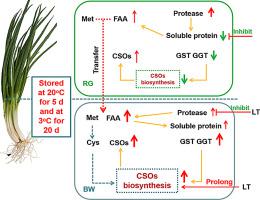Scientia Horticulturae ( IF 4.3 ) Pub Date : 2022-05-26 , DOI: 10.1016/j.scienta.2022.111191 Xiaomei Dai , Haitao Yu , Lijuan Zhu , Zhifang Yu

|
The purpose of this study was to investigate the dynamics in S-alk(en)ylcysteine sulfoxides (CSOs) biosynthesis and free amino acids (FAA) accumulation and remobilization in different parts of chive during postharvest storage. The chives were stored for 5 days at 20 °C (RT) and 20 days at 3 °C (LT). The CSOs and most of the FAA accumulated in the bottom-white part (BW) during chive senescence in the round-green part (RG) during the storage. There was a strong correlation (0.75<r<0.96, P<0.001) between the CSOs and FAA changes in the RG and the BW of the chive. In the BW of the chive, the total CSOs content increased by 17.53 % under RT and 38.06 % under LT storage, while the content of total FAA increased by 443 % under RT and 464 % during LT storage. However the CSOs and FAA changed much less in the RG of the chive during the storage. The FAA, glutathione S-transferase (GST) and γ-glutamyl dipeptidase (GGT) results further indicated that the CSOs were biosynthesized in whole parts but much higher in the BW part during storage. The product of proteolysis (Met and Ser) provided the material for the biosynthesis of CSOs via Cys the pathway. The change in the CSOs and FAA profile in RG and BW of chive during storage was through a source-to-sink transition phenomenon, which resulted in the remobilization of the nutrient (S and N) from the RG to BW parts of the chive. The LT storage increased CSOs accumulation by prolonging the storage time, delayed FAA accumulation by inhibiting proteolysis and increased protein content in the BW during the storage. Our study's results provide new insight into the CSOs biosynthesis of postharvest chive and the role of storage temperatures on S-alk(en)ylcysteine sulfoxides biosynthesis and FAA remobilization in postharvest chive.
中文翻译:

采后细香葱 (Allium schoenoprasum L.) 不同部位的 S-alk(en)ylcysteine sulfoxides 生物合成和游离氨基酸谱
本研究的目的是调查 S-alk(en)ylcysteine sulfoxides (CSOs) 生物合成和游离氨基酸 (FAA) 在采后贮藏期间在韭菜不同部位的积累和再活化的动力学。细香葱在 20 °C (RT) 下储存 5 天,在 3 °C (LT) 下储存 20 天。CSOs 和大部分 FAA 在储存期间在圆形绿色部分 (RG) 中在韭菜衰老期间积累在底部白色部分 (BW)。CSOs 与 FAA 的 RG 和韭菜 BW 的变化之间存在很强的相关性(0.75<r<0.96,P<0.001)。在细香葱的BW中,CSOs的总含量在RT下增加了17.53%,在LT下增加了38.06%,而FAA在RT下增加了443%,在LT下增加了464%。然而,CSOs 和 FAA 在储存期间韭菜 RG 的变化要小得多。FAA、谷胱甘肽 S-转移酶 (GST) 和 γ-谷氨酰二肽酶 (GGT) 结果进一步表明,CSOs 是整体生物合成的,但在储存过程中 BW 部分的生物合成量要高得多。蛋白水解产物(Met 和 Ser)为通过 Cys 途径生物合成 CSOs 提供了材料。贮藏期间细香葱 RG 和 BW 中 CSO 和 FAA 分布的变化是通过源-汇转变现象,导致养分(S 和 N)从 RG 重新迁移到细香葱的 BW 部分。LT 储存通过延长储存时间增加了 CSOs 的积累,通过抑制蛋白水解延迟了 FAA 的积累,并在储存期间增加了 BW 中的蛋白质含量。我们的研究'



























 京公网安备 11010802027423号
京公网安备 11010802027423号